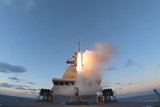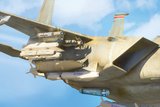How satcom is shaping the future of fast, accurate warfare (podcast)
This In Conversation podcast is brought to you by Shephard in partnership with Amazon Kuiper Government Solutions.
Listen on Apple Podcasts, Amazon Music, Spotify and more.
As militaries seek faster, more accurate decision-making across increasingly complex battlespaces, satcom services are becoming increasingly essential. The growing demand for real-time data and resilient connectivity is driving interest in new delivery models – including space-as-a-service.
Amazon’s Project Kuiper is working with government customers to expand access to space in ways that reduce costs and risks without sacrificing speed or accuracy. Its satellite services aim to keep pace with fast-moving technologies and the changing demands of modern warfare.
Speaking on the Shephard Defence Podcast, Rick Freeman, president of Amazon Kuiper Government Solutions (KGS), explained how satellite technologies are designed to integrate into networked battle systems – and why educating military leaders on the value of innovation is a priority.
Moving toward the space-as-a-service model
Freeman defined space-as-a-service in the satellite communications field as “a business model where companies can access and use satellite services on a subscription or pay-as-you-go basis.”
Instead of militaries owning and operating their own satellite infrastructure, Freeman said the space-as-a-service model “democratises access to space by offering services like satellite data, launch capabilities, ground station access and communications, making it less risky for customers to utilise space-based assets.”
“This is a fundamental shift we understand in the acquisition process, because it moves the government from ownership to outcomes,” said Freeman. “Traditionally, government bought hardware and hoped it lasted.”
He said the old model created problems for defence forces: “You’re locked into day-one technology, when threats, of course, are evolving continuously so acquisition leaders are forced to procure technology, satellites, transponders and the like, when what mission commanders really need is assured connectivity with specific performance characteristics.”
Instead, space-as-a-service “tends to turn that equation on its head”. Freeman explained that this is because operators will have a portfolio of capabilities, which breaks down capability silos. Therefore, customers are no longer tied to service-specific satellites or proprietary ground infrastructure, allowing for joint operations from the start of a mission.
Building on connectivity
Along with connectivity, Freeman outlined the three layers necessary for creating connected battlespaces: enabling, applications, and command and control. First, the enabling layer focuses on securing a multi-orbital mesh network and identity-driven access across domains.
“The applications layer overlays the network or is connected through the network,” Freeman continued. “We’re talking mission-critical applications that are service-agnostic and interoperable by design.”
These applications produce a common operational picture, described by Freeman as “the single pane of glass” where multi-intelligence correlation and coordination can occur, especially when joint forces are involved.
“The command and control later represents connectivity or artificial intelligence at the edge – this is where cloud native capabilities meet the tactical reality edge, processing nodes, running machine-learning models, automating data flow, pushing relevant info without manual tasking, or in some cases, with humans in the loop, which can slow or expand the time in the kill chain,” said Freeman.
These three layers need to work in concert for the best battlespace outcomes, according to Freeman. This means timeframes for decision-making and kill chains, even when personnel are thousands of miles apart, can be compressed from hours and days to minutes and seconds.
Prioritising speed and accuracy
Freeman emphasised the importance of moving data “at the speed of relevance”, without compromising accuracy, using "strategies and technologies, like artificial intelligence, open standards and advanced sensors to accelerate the time it takes to find, fix, track, target, engage and assess an enemy via satellite communications – this acceleration is critical in a competitive environment where speed is the key advantage and accuracy is the key outcome.”
“For networked battlefield systems and remote weapons systems, any latency can have severe consequences on mission success,” said Freeman. “The military needs to seamlessly communicate across land, air, sea, and space, coordinating troop movements, vehicle manoeuvres and remote drone operations.”
Increasingly, fast, accurate data analysis is becoming more important for making quick decisions in battlespaces. Freeman cited the example of the US Department of Defense’s Joint All-Domain Command and Control strategy, which requires high-speed networks to process and analyse data across all military commands in near-real time using AI and cloud-based computing.
When asked about the importance of accuracy, Freeman said navigation and targeting systems, such as GPS, rely on precise timing for accurate positioning.
“Any error can lead to significant positional inaccuracies for forces on the ground, ships at sea, or guided munitions.
“We focus also on guaranteeing data integrity and data security,” Freeman continued. “The Department of Defense requires various encryption techniques to prevent intercepting and decrypting sensitive info, so maintaining data integrity is critical in preventing exploitation of cyber vulnerabilities.”
Shifting mindsets among military leaders
Educating military leaders on the benefits of new technologies to achieve buy-in from all stakeholders is an important part of KGS’s work. When asked if those leaders are adapting to technology-driven warfare, Freeman said: “Change takes time, but we are seeing military leaders adapting to space as a warfighting domain, first by focusing ever-increasing resources on deterrence, resilience and domain awareness, building distributed architectures, integrating space and cyberspace operations, and developing new training and operational strategies."
One of Freeman’s significant concerns is focusing on creating networks of satellites around systems that can work together and are compatible with allies to ensure continuous operation.
“Interoperability is a critical focus for warfighters, and we see continuously that mindset shifting into more of a hybrid commercial and government capability, because we are able to innovate at speeds far greater than the current defence acquisition process will allow.”
The role of AI solutions
AI is being used to support the work of humans in the military, rather than replace them. Freeman said that AI enables autonomous network management, real-time threat detection, and optimised resource utilisation in military communications.
“AI is allowing us to reduce the need for manual intervention – this is a constant in the concept of how we compress the time from threat to engaging of that threat,” he said, adding that this means critical information reaches military personnel “swiftly and securely, even in contested environments”.
With cyber attacks playing a bigger part in modern warfare, Freeman said AI has a key role to play.
“AI provides advanced threat detection by monitoring communications traffic across the satcom network, looking for malicious activity, detecting irregularities, and automatically triggering security protocols to protect sensitive military data from cyber attacks and jamming signals.”
A cyber-focused future
Looking ahead to the next five years, Freeman said the cyber domain will become a key battlespace, along with land, sea, air and space. Managing this new frontier, with the constant threat of sophisticated cyber attacks, will be an “enormous undertaking that will require incredible amounts of data management and coordination across multiple disparate forces.”
Freeman highlighted the importance of synchronisation and integration of US and allied forces, as well as relevant non-military activities, in managing multi-domain operations. Connectivity will be critical, especially in operations with “austere, temporary locations around the world without infrastructure,” he said.
Freeman expects “the ubiquity of drone technology and unmanned systems” to continue, with increasingly sophisticated data integration essential for proper management and deployment.
Here, AI-enabled courses of action will play a growing role in processing complex datasets in real time.
“I look for intelligent constellation management where AI will automate the complex task of coordinating the tens of thousands of satellites and mega-constellations – it will optimise resource allocation, scheduling, link management, and space situational awareness, and adapt to changing demands as we grow the constellations.
“I fully expect global connectivity to be the critical key because operations are increasingly global, requiring seamless communication, regardless of location,” Freeman elaborated.
“Satcoms are critical and will remain critical for connecting dispersed units and enabling logistics and sustainment across vast distances.”
- Project Kuiper has now been rebranded as Amazon Leo. To find out more about space-as-a-service by Amazon LEO, click here
More from The Shephard Defence Podcast
-
![Precision on Demand: The New Age of Loitering Weapons (Podcast)]()
Precision on Demand: The New Age of Loitering Weapons (Podcast)
Loitering munitions provide vital capabilities in the disrupted and unpredictable modern battlespace, from real-time ISR to a virtually “on demand” strike capability. Rafael is looking to the future of the technology, empowering systems to operate with increasing autonomy in hostile environments.
-
![Defending the Fleet: Naval air defence in the drone era (podcast)]()
Defending the Fleet: Naval air defence in the drone era (podcast)
In an era of swarming drones, proliferating missiles and saturation attacks, naval air defence must combine cutting-edge effectiveness with low cost per intercept. Israel’s Rafael is applying its long expertise to help navies adapt to emerging threats, while looking to a future of laser technology – and beyond.
-
![Energy evolution: How laser defence systems are powering the next phase of air defence (podcast)]()
Energy evolution: How laser defence systems are powering the next phase of air defence (podcast)
Laser-based air defence is moving from promise to deployment as global threats evolve. In this special podcast, we explore how high-energy laser systems are reshaping interception strategies.
-
![Combat-proven capabilities: How precision-strike systems are evolving for tomorrow’s battlespace (podcast)]()
Combat-proven capabilities: How precision-strike systems are evolving for tomorrow’s battlespace (podcast)
Combat-tested technology is being reshaped to counter A2/AD threats, reduce reliance on GPS and enable faster, more autonomous targeting in complex environments. In this special podcast, experts explain how the evolving threat landscape is shaping next-generation strike capabilities.
-
![Why tactical UAVs are winning on the future battlefield (Podcast)]()
Why tactical UAVs are winning on the future battlefield (Podcast)
In Conversation: In this special edition of the Shephard Defence Podcast, Tony Skinner sits down with Dan Slasky, President and CEO of Aeronautics, to explore how cutting-edge tactical unmanned aerial systems are reshaping today’s battlefields.
-
![Podcast: The evolving landscape of military simulation and training technologies]()
Podcast: The evolving landscape of military simulation and training technologies
This week on the Shephard Defence Podcast, we explore the evolution of military simulation and training technologies, including advancements in cloud computing, networked training, and the increasing use of simulation in response to changing military demands.
























